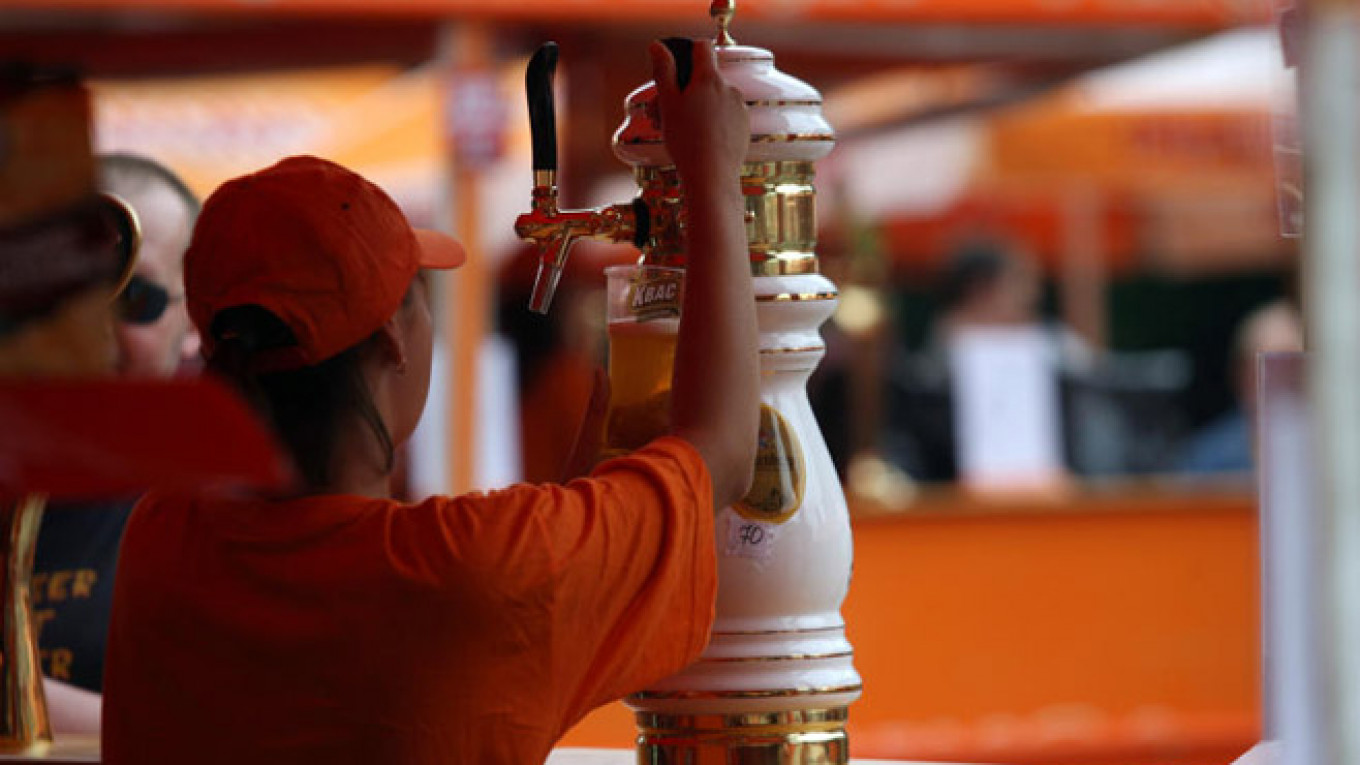Shrinking appetites for beer are turning kvas, a traditional soft drink made from fermented bread or grain, into a huge growth market.
Russian producers are cranking up production and trumpeting the health benefits of the 1,000-year-old brew, and after sales of kvas grew by 11-12 percent last year, according to consumer behavior research firm Nielsen, even big multinationals have begun to sit up and take notice.
Heineken, one of the largest brewers in the world, announced in April it would produce kvas at its four plants around Russia.
But as big players crowd the market, artisan kvas is struggling to compete.
“Small local companies have practically no chance of getting into big retail stores,” said Vladimir Antonov, vice president of Ochakovo Group, a major Russian beer and soft drinks manufacturer.
1,000-Year History
Rich-smelling and dark brown, kvas was first mentioned in ancient Russian chronicles at the beginning of the 11th century. Back then, it was a strong alcoholic drink, and only a century later did a low-alcohol kvas appear.
The strong and weak versions co-existed for hundreds of years until the arrival of vodka in Russia in the 16th century ended demand for highly-alcoholic kvas. Now, the drink’s alcohol content does not exceed 1.5 percent.
Kvas was extremely popular during the Soviet era and was sold in yellow wheeled barrels in the summertime. But these largely disappeared from the streets in 1990s, when new requirements for transportation and storage were introduced.
Without barrels, kvas makers had to switch to bottles. But this took time. Ochakovo was the first company to start bottling kvas in 1996.
Soviet kvas had been unfiltered and flat, but in the 1990s, as Coca-Cola and other soft drinks entered Russia’s newly capitalist market, manufacturers began producing a carbonated, sanitized version.
Producers say the drink is packed with vitamins and minerals, improves digestion, prevents hangovers and stabilizes the immune system.
Less Beer, More Kvas
One reason for the booming popularity of kvas is falling beer consumption prompted by rising prices.
Beer production last year dropped by 7.6 percent, data from the Ros?stat state statistics service show. According to Ochakovo, the beer market had fallen by more than 30 percent over the past 7 years.
“Many people who can’t afford beer any more have switched to drinking [either] strong alcoholic drinks or kvas,” said Antonov.
The average price of a liter of beer rose by 12 percent last year to 84 rubles ($1.7), according to Nielsen. A liter of kvas costs on average 40 rubles ($0.8), he said.
Five years ago the average price of a liter of beer and kvas was 50 and 25 rubles, respectively, according to research by Russian beer analysts Pivnoye Delo in 2010, meaning that the cost of both drinks has increased by around 40 percent in half a decade.
Beer price inflation has been fueled by taxes, which have risen from 3 to 18 rubles per liter since 2010, according to Ochakovo, and by new restrictions on when, where, and under what conditions alcoholic drinks can be sold in Russia.
Seasonal Business
But unlike beer, kvas is a seasonal business. Russians drink it in summer, when kvas sellers pop up on city streets in their hundreds.
“Demand for kvas fully depends on the weather,” said Antonov. “As soon as the temperature starts rising, we maximize production.”
Kvas consumption can increase in summer by up to 10 times, according to manufacturers. During the abnormally hot summer of 2010, production of kvas reached 856.1 million liters, 15 percent more than in 2011, when there was no heat wave, according to a report by Businesstat, a Russian market research company.
By 2019, kvas output is expected to grow by almost 18 percent from 2014 levels to hit 891 million liters, the Businesstat report said.
Artisan Kvas
Big brewing firms are insulated from seasonal decline in demand for kvas because they usually have other drinks to offer to consumers. At Ochakovo, for example, kvas accounts for around one-third of sales. Two-thirds come from beer, Antonov said.
But small local manufacturers have to find more creative ways to compensate for their losses in winter period.
“We produce kvas only in summer. The rest of the time we make and sell plastic dinnerware,” said Eduard Avetisyan, director of Volgograd-based company Russky Kvas.
Russia is full of local kvas producers, but small brewers struggle to enter the market.
“The Russian market for bottled kvas is saturated. It’s extremely hard to get your product into stores,” said Avetisyan.
Correction: An earlier version of this article said Vladimir Antonov was general director of Ochakovo. In fact, he is the company's vice president.
Contact the author at bizreporter@imedia.ru
A Message from The Moscow Times:
Dear readers,
We are facing unprecedented challenges. Russia's Prosecutor General's Office has designated The Moscow Times as an "undesirable" organization, criminalizing our work and putting our staff at risk of prosecution. This follows our earlier unjust labeling as a "foreign agent."
These actions are direct attempts to silence independent journalism in Russia. The authorities claim our work "discredits the decisions of the Russian leadership." We see things differently: we strive to provide accurate, unbiased reporting on Russia.
We, the journalists of The Moscow Times, refuse to be silenced. But to continue our work, we need your help.
Your support, no matter how small, makes a world of difference. If you can, please support us monthly starting from just $2. It's quick to set up, and every contribution makes a significant impact.
By supporting The Moscow Times, you're defending open, independent journalism in the face of repression. Thank you for standing with us.
Remind me later.


